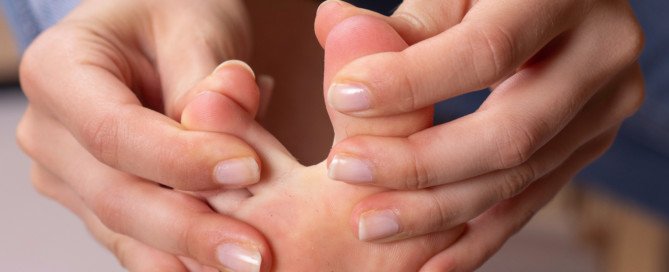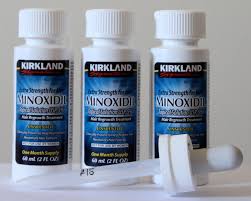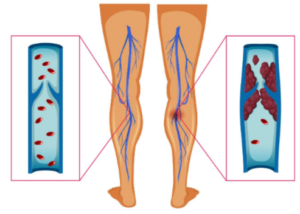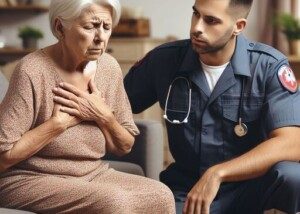Might a New Mole Between the Toes Be a Melanoma?

If you have a new mole or “spot” between your toes, do NOT blow it off as possible melanoma just because no sun gets between your toes.
“Yes, melanomas can grow in areas that typically do not receive much sunlight,” says Dr. Janet Prystowsky, board certified dermatologist in New York, NY, with 30+ years’ experience.
“This is because the effects of sun damage aren’t always localized. A sunburn on your back, for example, increases your risk of melanoma in general, not necessarily only on your back.”
Bad News
So if you received a blistering sunburn as a child, this means your risk of melanoma anywhere on your body has been increased.
However, you need not suffer from any sunburns in order to get melanoma. A sunburn-free life does not get you off the hook from this skin cancer.
Melanoma can grow on the skin – ANYWHERE. This cancer arises from melanocytes—the cells that produce pigment in the skin.
Where there is skin or a mole, there can arise melanoma, with only about one-third of these tumors arising in pre-existing moles.
This means your monthly self-exams should include all areas of skin – including between the toes, and including any mole that you’ve had between your toes since the day you could remember.
Checking for Melanoma Between the Toes

Shutterstock/sruilk
It certainly helps if you’re flexible. You can prop a foot up on the sink, spread your toes and examine for any new moles, spots or bumps, or any changes in a pre-existing mole, even if it’s tiny.
Incorporate the use of a mirror to check between your toes from behind, as well as behind your toes and the soles of your feet.
Another reason why melanoma can appear in areas that have received very little sun exposure is because there are other factors in the development of this disease: factors not completely understood by researchers.
This is why not all sunburned white people or pale skinned redheads get melanoma, and why some patients have had no sunburns ever and/or have dark skin, and/or dark hair and brown eyes.
Before you go outside for extended periods in sandals or flip-flops, put sunscreen all over your feet and between your toes.
And foot exams for melanoma are yet one more incentive to improve your flexibility – so you can get up as close as possible to view your skin and moles.

In combination with her focus on early skin cancer detection and removal, Dr. Prystowsky provides a wide range of revitalizing and rejuvenating treatments.
 Lorra Garrick has been covering medical, fitness and cybersecurity topics for many years, having written thousands of articles for print magazines and websites, including as a ghostwriter. She’s also a former ACE-certified personal trainer.
Lorra Garrick has been covering medical, fitness and cybersecurity topics for many years, having written thousands of articles for print magazines and websites, including as a ghostwriter. She’s also a former ACE-certified personal trainer.
When Brown Mole Turns Red: Melanoma or Nothing to Worry About?
Melanomas from Existing Moles vs. As New Spots on Skin

There are differences between melanomas that arise from existing moles and those that appear as brand new spots on skin where there’s no original mole. (more…)
You Know You Probably Have Sleep Apnea When…

Sleep apnea not only is one of the most misdiagnosed conditions.
But many undiagnosed people are in denial that they might actually have it.
Though the stereotypical patient is an overweight middle aged man with a short thick neck, even skinny young children can be diagnosed with sleep apnea.
Three Kinds of Sleep Apnea
• Obstructive – Associated with structural issues with the throat as well as over-relaxed throat muscles. Obesity and male gender are risk factors, but thin people including women can have it.
• Central – The brain fails to send proper signals to the muscles that control breathing.
• Complex – Having both obstructive and central types.
Sleep apnea is a risk factor for heart disease, heart attack, stroke and vehicular accidents (due to the drowsiness and impaired alertness).
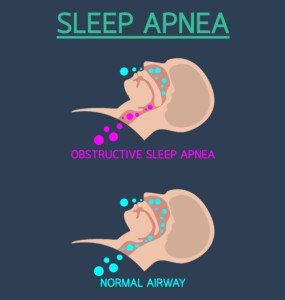
Shutterstock/iLoveCoffeeDesign
You Know You Probably Have Sleep Apnea When…
“You’re now sleeping on the couch because your bedpartner can’t take your snoring,” says Joseph Krainin, MD, board certified in sleep medicine and neurology and founder of online sleep apnea clinic Singular Sleep.
“Your bedpartner says, ‘I think I heard you die for a moment last night in your sleep,’” continues Dr. Krainin.
“You wake up after a full-night of sleep just as tired as when you went to bed.”
And you continue feeling as tired as a dog despite being up and about for an hour or two, even after washing your face and eating breakfast.
“You’re known around the office as ‘that person who always falls asleep in meetings’ at work,” says Dr. Krainin.
You also can be pretty sure you have sleep apnea when you feel a need for several naps throughout the day despite sleeping for eight hours (or what seems like eight hours).
Another tip-off that you likely have sleep apnea is that lately, you’ve become uncharacteristically irritable and grouchy, and/or have new-onset difficulty concentrating and focusing – that cannot be explained with changes in life situation or new medications.
Another red flag for sleep apnea is that, despite being well into adulthood, you’ve recently been diagnosed with attention deficit hyperactivity disorder (ADHD) or attention deficit disorder (ADD).
Did you know that the symptoms of sleep apnea and the symptoms that comprise ADHD or ADD are strikingly similar?
Not the snoring, of course, nor the gasps for breath while you sleep. But the mental or cognitive symptoms of sleep apnea are virtually identical to those of ADHD/ADD.
This is why when children are diagnosed with ADHD, parents need to zip them straight over to a sleep doctor for a full evaluation.
You may also have sleep apnea when your bed partner reports that you go long periods without breathing while asleep.
Your stomach suddenly stops rising up and down; it’s dead still – as though you’re dead. Then suddenly it goes up again for a breath, and breathing resumes.
Another red flag: Suddenly awakening feeling you can’t get in a breath.
And there’s more: awakening with headache (the deprived oxygen during sleep shorts the brain of oxygen).
Let’s not forget insomnia.
All of these symptoms can also be caused by unrelated issues.
But the more you have, the higher the index of suspicion for sleep apnea!
- Loud snoring
- Paused breathing
- Gasping while asleep
- Snorting during sleep
- Frequent urination overnight
- Restless, fidgeting sleep
- Frequent awakenings
- Waking unrefreshed
- Jaw soreness on waking
- Dry mouth on waking
- Sore throat on waking
- Morning headaches
- Poor concentration
- Reduced attention span
- Irritability or moodiness
- Brain fog
- Hypertension that doesn’t respond to treatment
- Daytime fatigue
- Frequent naps watching TV
- Dozing off when driving
 In 2013 Dr. Krainin was elected a Fellow of the American Academy of Sleep Medicine, an honor reserved for sleep doctors who’ve made significant contributions to the field in education, research and service.
In 2013 Dr. Krainin was elected a Fellow of the American Academy of Sleep Medicine, an honor reserved for sleep doctors who’ve made significant contributions to the field in education, research and service.
 Lorra Garrick has been covering medical, fitness and cybersecurity topics for many years, having written thousands of articles for print magazines and websites, including as a ghostwriter. She’s also a former ACE-certified personal trainer.
Lorra Garrick has been covering medical, fitness and cybersecurity topics for many years, having written thousands of articles for print magazines and websites, including as a ghostwriter. She’s also a former ACE-certified personal trainer.
Reasons Your Forearm Muscles Are Twitching: ALS Possible?

The forearm muscles are a unique muscle group, so when they start twitching, this is easily felt and even sometimes seen, raising the issue of ALS.
The forearm muscles are primarily responsible for wrist and hand movement.
If you’re worried about ALS because your forearm muscles are twitching, chances are highly likely that you googled some keywords that led you straight to ALS search results.
“If you consult ‘Dr. Google’ you might get yourself pretty worried because you are likely to find that ALS often presents with muscle twitches,” says Joseph Krainin, MD, board certified neurologist and sleep doctor.
Causes of Muscle Twitching in the Forearms
Dr. Krainin continues, “However, by far, ALS is NOT the most likely cause of forearm muscle twitches.
“Overall, the most common cause of muscle twitches is called benign fasciculations.
“As the name implies, this condition is not dangerous and is ‘self-limited,’ i.e., goes away on its own with time.
“If you have been overusing or carrying a lot of tension in your forearm muscles, you might be predisposed to getting benign fasciculations in these muscles.
“Activities such as racket sports and yoga can be very demanding on your forearms.” So can rock or wall climbing and lifting weights.

Shutterstock/Luka Funduk
Time passage is on your side. If over a period of several weeks, two months for sure, you have not noticed any weakness in your forearms, it’s a safe bet that you do not have any serious disease.
However, be careful with how you conduct strength tests for your forearm muscles.
For example, if you’ve never done wrist rolls against resistance before, and create a device with which to do this or use the device at your gym, your forearms and wrists will fatigue very quickly.
You’ll then probably start convincing yourself you have weakness.
If your forearms have a pathological weakness, you’ll know it. Anything that involves wrist action and gripping will falter, such as grabbing a half gallon milk carton out of the refrigerator with one hand and pouring the milk.
Lifting dumbbells to get into position for dumbbell presses is another movement that will greatly manifest pathological forearm weakness.
The list is endless, as we need our hands and wrists for so many daily tasks, including starting our car and putting on our seatbelts.
Forearm Muscle Twitching
There is nothing unique about the muscles in this location that would mean that their twitching is more suggestive of ALS or some other disease, when compared to fasciculations at other body locations.
Visibility of fasciculations, as well, is not indicative of the potential or odds that this might be caused by a motor neuron condition.
If you haven’t been doing racket sports, yoga, weightlifting or climbing, what could be causing your forearm muscles to twitch?
Anxiety, general fatigue and physical activity involving the upper body are leading causes, and the fasciculations can occur anywhere.
 Double board certified in sleep medicine and neurology, Dr. Krainin is founder and president of Singular Sleep, LLC, an award-winning online sleep center.
Double board certified in sleep medicine and neurology, Dr. Krainin is founder and president of Singular Sleep, LLC, an award-winning online sleep center.
 Lorra Garrick has been covering medical, fitness and cybersecurity topics for many years, having written thousands of articles for print magazines and websites, including as a ghostwriter. She’s also a former ACE-certified personal trainer.
Lorra Garrick has been covering medical, fitness and cybersecurity topics for many years, having written thousands of articles for print magazines and websites, including as a ghostwriter. She’s also a former ACE-certified personal trainer.
.
Top image: ©Lorra Garrick
Cure for Flaky Itchy Scalp Caused by Minoxidil: Simple Remedy

If minoxidil is causing your scalp to be itchy and flaky with white specks in your hair, there is a simple remedy for this problem.
An itching and/or flaking scalp, when caused by minoxidil, is usually caused by the 5 percent men’s solution applied twice a day. (more…)
What Happens in the ER When You Hit Your Head Hard: Tests

If you go to the ER fully conscious but report having hit your head hard, here’s exactly what to expect. (more…)
What to Expect in the ER if You Have Shortness of Breath

If you’re complaining of shortness of breath or difficulty breathing, here is what will be done for you in an emergency room. (more…)
Child Hit Head? Questions to Ask ER Doctor re CT Scans
If your child got hit in the head, you need to make sure they don’t get unnecessary CT scans.
Here’s questions to ask the ER doctor if you’re worried about radiation exposure.
CT scans take about 15 minutes and are easy to conduct. Not all doctors in an emergency room setting practice the same screening protocol when it comes to deciding to order a CT scan for a child who’s been hit in the head.
CT scans can be life-saving, being that they can show a brain bleed as a result of getting hit in the head – which children often do during play or from accidents.
The chart below shows radiation exposure from a CT scan of the head compared to other common sources of radiation.

Questions Parents Should Ask About CT Scans for Kids’ Head Trauma
• Ask if the CT scan is necessary. Do not fear being thought of as “challenging a doctor” by asking this question. Think of yourself as an inquiring customer. You have a right to ask this question.
• Ask about other options such as MRI or ultrasound, as these do not use radiation. However, chances are high that an ER is not going to give an MRI for head trauma since it takes much longer.
• If the ER doctor will order only a CT scan, ask how the radiation dose will be adjusted to ensure use of minimal radiation.
• The answer to this question should include whether or not the staff has the expertise to ensure minimal radiation.
What if Child Seems to Have Only a Minor Head Injury?
The above questions apply, but there’s a few more questions you should ask the ER doctor if your child seems okay.
• Can a watchful waiting approach, in the emergency room, be taken instead of a hasty CT scan?
• If there’s no evidence of worsening symptoms, can the CT scan be put on hold while the child is held for several hours of observation?
• Be prepared for that—several hours—as this is what’s necessary for doctors to gain a strong foothold on whether or not head trauma can be serious or is truly minor.
• Ask about looking out for a change in, or worsening of, symptoms (if any) over those several hours as being the warrant for a CT scan rather than just the claim, “My child hit her head.”
Symptoms for Parents to Watch Out For
“If any symptoms appear after a head injury, a doctor should be immediately consulted,” says Dr. Lisa Lewis, MD, a board certified pediatrician in Fort Worth, Texas, and author of “Feed the Baby Hummus, Pediatrician-Backed Secrets from Cultures Around the World.”
“Although not as common as a concussion, brain hemorrhage (a bleed in the brain) can be life-threatening and require immediate intervention,” says Dr. Lewis.
“Symptoms to look out for that will warrant an immediate ER visit: vomiting, loss of consciousness, altered mental state, difficulty walking, not able to eat or talk, difficulty awakening.”
A worsening headache and nausea are also symptoms to take seriously and warrant an ER trip.
Having 25+ years’ experience, Dr. Lewis completed her pediatrics residency at Texas A&M University Health Science Center, Scott and White Memorial Hospital. For two years afterward she was assistant professor in the department of pediatrics at Texas A&M University Health Science Center.
 Lorra Garrick has been covering medical, fitness and cybersecurity topics for many years, having written thousands of articles for print magazines and websites, including as a ghostwriter. She’s also a former ACE-certified personal trainer.
Lorra Garrick has been covering medical, fitness and cybersecurity topics for many years, having written thousands of articles for print magazines and websites, including as a ghostwriter. She’s also a former ACE-certified personal trainer.
What Is Hyperhidrosis and Might You Have It?

Hyperhidrosis is a very bothersome condition that can impede the quality of one’s social life.
It can bring on enough embarassment to make the sufferer want to stay home.
“Hyperhidrosis is a condition that in any circumstances where a person would normally sweat (whatever the cause), those with the condition will sweat far more relative to volume .– four or five times more than what’s considered normal,” says registered nurse and emergency medical technician Angela Ballard, RN, EMT, with the International Hyperhidrosis Society (www.SweatHelp.org). (more…)
Does Hyperhidrosis Go Away with Age? Can You Outgrow Sweat?

Hyperhidrosis of the armpits, groin or feet–it can be bad enough to impair social life.
But is there hope as the sufferer gets older?
Can you “age out” of hyperhidrosis?
Hyperhidrosis is the medical term for excessive sweating. It can occur anywhere, but when it affects the armpits and feet, the odor becomes an issue in addition to the sweat.
If the groin is affected, this is really uncomfortable.
It can be so bad that several changes of underwear a day are necessary.
Too Old for Hyperhidrosis?
There’s a belief circulating that people who suffer from excessive sweating, which can also affect the hands and beneath the breasts, will outgrow this condition as they get older.
After all, how many elderly people do you know who complain of hyperhidrosis?
Then again, how many people of any age reveal this problem to family and friends?
They know it may be taken as poor hygiene rather than as a medical condition.
- But what really is the truth?
- Is advancing age the best treatment for excessive sweating?
“No, contrary to popular belief, research shows that hyperhidrosis does not go away or decrease with age,” says registered nurse and emergency medical technician Angela Ballard, RN, EMT, with the International Hyperhidrosis Society (www.SweatHelp.org).
“In fact, in one recent IHhS study, 88 percent of respondents said their excessive sweating had gotten worse or stayed the same over time,” continues Ballard.
“This was consistent across all the different age groups, from youngsters to older adults.
“Research from the IHhS also shows that profuse sweating is not simply dictated by the time of year (i.e., hot summer months).”
Nor is it simply a function of rigorous physical activity. It can occur during sedentary periods.
“The majority of patients in one survey indicated that their sweating bothers them equally, no matter the season,” says Ballard.
 Angela Ballard has been working with the International Hyperhidrosis Society (IHhS) since it’s inception in 2003.
Angela Ballard has been working with the International Hyperhidrosis Society (IHhS) since it’s inception in 2003.
 Lorra Garrick has been covering medical, fitness and cybersecurity topics for many years, having written thousands of articles for print magazines and websites, including as a ghostwriter. She’s also a former ACE-certified personal trainer.
Lorra Garrick has been covering medical, fitness and cybersecurity topics for many years, having written thousands of articles for print magazines and websites, including as a ghostwriter. She’s also a former ACE-certified personal trainer.
.

